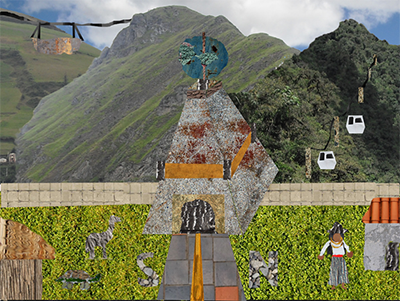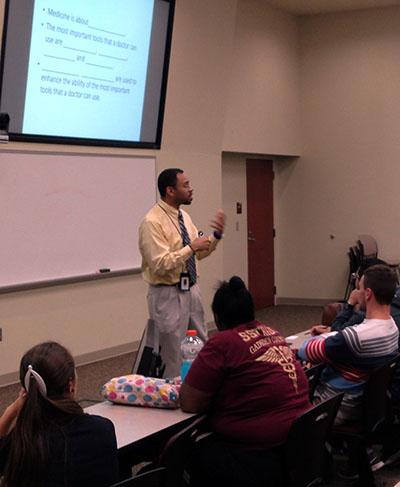¡Si se puede! (Yes we can!)
This year Dr Rodriguez and a group of medical students travelled to Ecuador for a 10 day cultural immersion and medical mission trip. As it was during the world cup, and Ecuador had a team there—chants of ¡Si se puede! were heard everywhere. But for us as a group, it was also call of inspiration.
Before we left, we knew that there would be challenges for our clinical experiences. Ecuador already had a law that forbids foreign doctors from practicing medicine in Ecuador without the supervision of an Ecuadorian physician, but in the past, physicians were willing to work with our students. This year, however, a change in the malpractice law made doctors leery of supervising visiting medical students. We knew about the new law, but we still had hopes for a good trip. As the faculty member, I was concerned that the students would not have any meaningful clinical experiences. My concerns, however, proved to be unfounded.
We left for Ecuador on Monday, June 23 and arrived in Quito that night. Dr. Rojas, a friend and father of one of our medical students, met the students at the airport and took them to their hotel. My family retrieved me and we went to our lodging, which was very close to the student’s hotel.
The next day was spent at the Ciudad Mitad del Mundo, the most visited site in all of Ecuador. It is famous for its iconic obelisk, reproduced in abstract below. We traveled there with Dr. Rojas, ate some fabulous food, and learned about the many cultures of Ecuador. We then travelled to Colonial Quito, where we met a faculty member from the Pontificia Universidad Catolica del Ecuador (PUCE). She took the students around, while I suffered with a very sick stomach.
The next days were a blur. We travelled to the top of a mountain by cable car, went shopping, visited the cancer hospital across the street from the US embassy, witnessed the elimination of Ecuador from the world cup on a jumbo-tron in the street, and travelled to Alausí. The visit to the cancer hospital was very memorable, as we witnessed how state of the art technology was used to treat cancer patients from all over Ecuador. We learned the epidemiology of cancer in Ecuador, what the hospital is doing about it, and how we could help. The president and CEO of the hospital even came to greet us. We were amazed at how this person worked—he was a man in his eighties, who served as president for over 30 years. During his time, the hospital grew from a 3-bed hospital to one that has over 800 beds. He never took a salary!
We arrived in Alausí late Friday afternoon. The town was buzzing with excitement as they were celebrating the “Fiesta de San Pedro” to commemorate the founding of the city. There were amazing meals for sale on the street, fireworks, a carnival, and live entertainment in this small town of 15,000 people. The students and I stayed at the family home—which gave the students a taste of how people in the country really lived.
The next day we teamed up with “Encuentro Medico Alausi,” an organization run by Dr. Mario Orellana, and we saw patients for the next two days in the cultural hall of the town. Each day our partners and the medical students served more than 200 people. Most of the patients were indigenous—native Kichwa speakers, who struggled with Spanish. We learned about their lives and how much walking they do a day. We were working with the Ecuadorian Health Ministry, so they were able to provide a doctor and follow up for each of the patients we saw. Many of the students felt this was their most meaningful experience.
Because it was “fiestas” there were bullfights, “running of the bulls,” dances, parades and the coronation of the queen of the festival, Karlita 1. The students were able to take brief breaks to participate, and were dumbfounded by the beauty and majesty of the celebration.
We then went to Riobamba, where we visited an orphanage run by Canadian missionaries. Ark Children’s Home has been in Riobamba for over 20 years and is funded exclusively by international donations. Many years ago, I was inspired to adopt from a visit there, so that trip was nostalgic for me. That afternoon we had the unique opportunity to climb the highest mountain in Ecuador, Chimborazo, which towers over 6000 meters in the air. We began hiking at 4,800 meters and went all the way up to over 5000 meters. Some of our group became altitude sick, but all felt it was an amazing experience.
We took a break to bathe in the magical healing waters of Baños de Agua Santa, and then continued on to Quito. In Quito we ended our trip with a visit to the PUCE School of Medicine, and a visit to a separate orphanage called For His Children. My daughter was cared for there while we were completing our adoption paperwork. I could not have been more grateful for the care they gave her, and for looking out for her when I could not.
Without a doubt, this year’s trip has been the best one yet. I look forward to many more trips where I can share with the students the marvel that is Ecuador. I think next year we need to go to Galapagos!



.JPG)
.jpg)

.JPG) The Center for Underrepresented Minorities in Academic Medicine hosted Grand Rounds on November 13, 2014 featuring Dr. Jeanette E. South-Paul, MD, University of Pittsburg Medical Center Professor and Chair of the Department of Family Medicine. She met with the Council on Diversity and Inclusion, medical students and co-presented a Mentoring Workshop with Dr. Kendall Campbell entitled "Establishing Long Distance Mentoring Relationships". Her grand rounds presentation was titled "
The Center for Underrepresented Minorities in Academic Medicine hosted Grand Rounds on November 13, 2014 featuring Dr. Jeanette E. South-Paul, MD, University of Pittsburg Medical Center Professor and Chair of the Department of Family Medicine. She met with the Council on Diversity and Inclusion, medical students and co-presented a Mentoring Workshop with Dr. Kendall Campbell entitled "Establishing Long Distance Mentoring Relationships". Her grand rounds presentation was titled ".JPG)


